TaPRK
General
Projects
Shows
Excursions
Links
Yleistä
Ratoja
Projektit
Näyttelyt
Retket
Linkit
Parish/SRK
Tapiola Parish Model Railway ClubKauniainen, corner modules |
|---|
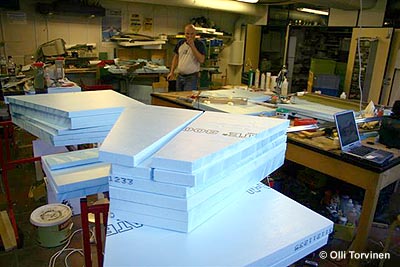
All parts for corner modules were cut together, even 3 sheets at a time using steel jigs....
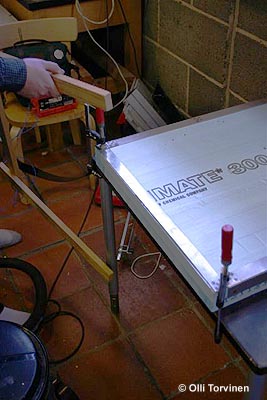
The factory cut edges also needed some touching up. here is one of the steel jigs...
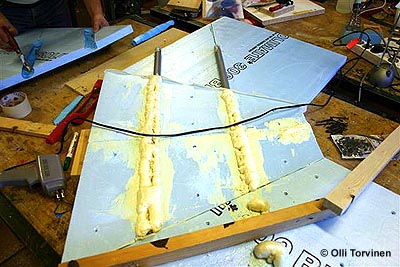
First proto curing: The corners were assembled from three sections and the framework consisted of two 30 mm sheets of EXPS ("blue foam"). The top sheet was carved to make space for 22mm plastic tubes that were glued in place with polyurethane foam. The sections of plastic tube are fitted on a metal tube of suitable diameter. This way the corner module sections may be assembled by just inserting the metal tubes into the plastic tubes and sliding the parts together. The proto corner had open cuts for the tubes in the middle part, the end peces had "ditches" and some holes for injecting the foam. The assembly order with the first unit was a bit different from the rest, here the plastic tubes were not pre-cut thus only two sections could be glued at once, so as to provide access to withdraw the metal tube before actually cutting the plastic tube. The rest of the corners had precut plastic tubes so all could be glued at the same time. The metal tube aligns the plastic tubes while foam sets. It's essentila that the tubes are exactly parallel, otherwise the sections will not come apart.
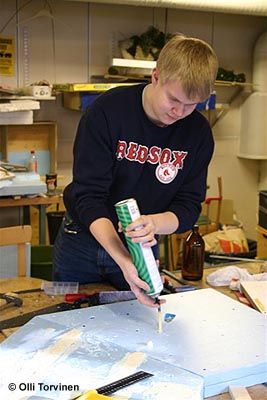
Olli is injecting the polyurethane foam through the openings to surround the tubes and fix them to blue foam...
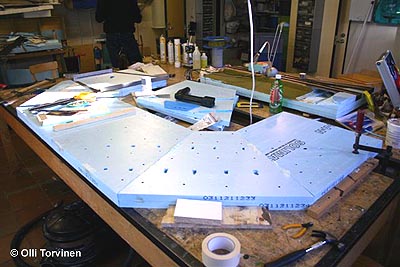
The second corner is having the other side carvedf for tubes, and is now fitted with tubes secured with nails and foam sheets joined with tile glue...
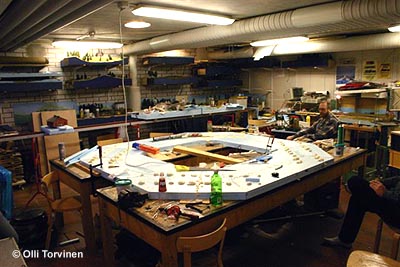
All four corners are now injected with polyurethane foam ...
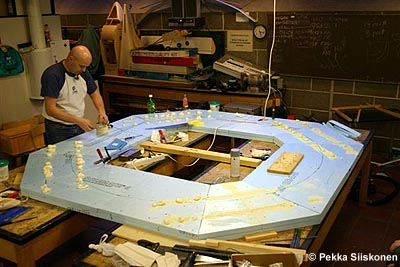
...and are left to set overnight in a jig assembled by fastening cleats to table surfaces...
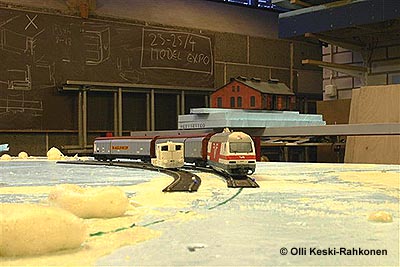
95 cm and 100 cm radius (38 and 40 in) is something we haven't had the pleasure
of injoying at Tapiola.
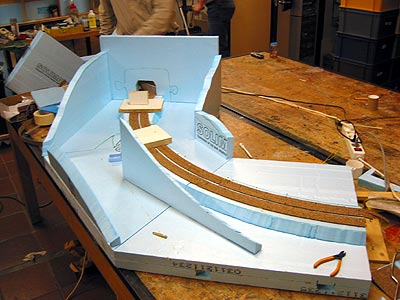
The next day the urethane foam expanded from the openings is cut away and
the module turned over to show the clean side. Embankment is cut and glued on place.
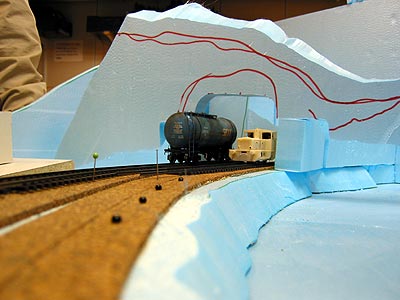
Tunnel mouth is precut and designed with NMRA gauge and fine tuned with some long models.
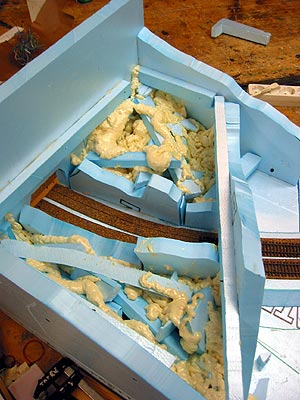
Our intent is to make the modules as light as possible.
Hence urethane foam and blue foam offcuts are used for support and filling.
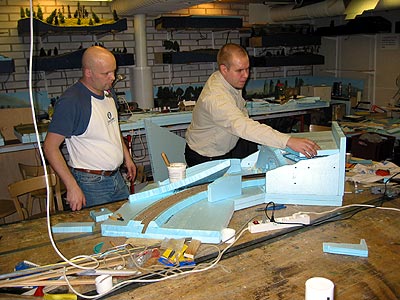
The tunnel top will be removable to gain access inside the tunnel.
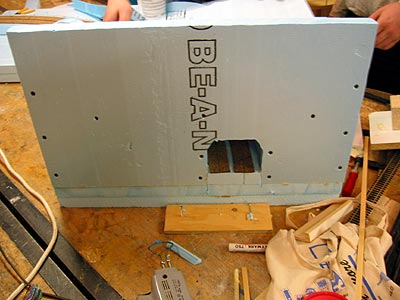
The module was designed so taht there would be no direct line of
visibility through the tunnel.
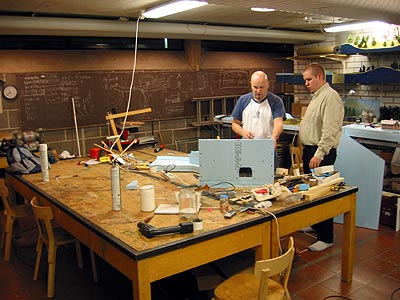
Pete and Opa working with the tunnel framework.
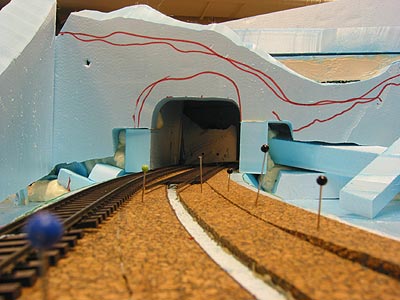
Here a track level view.
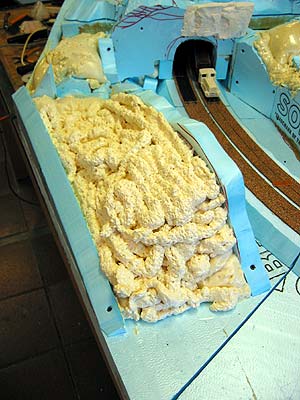
Fillings.
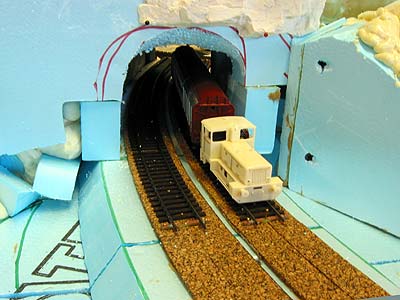
Some file tuning of the loading gauge was needed.
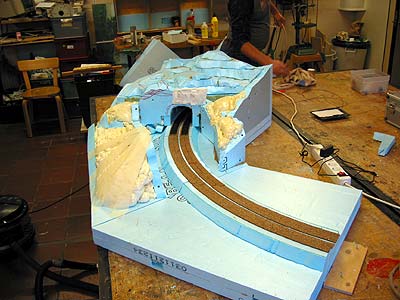
The framework is ready for 'Cellona' plaster bandage.
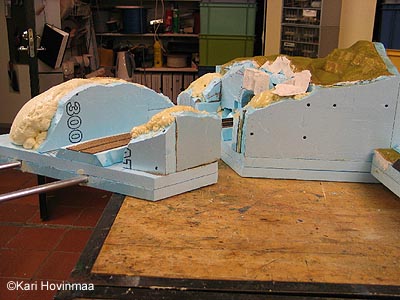
This picture shows the sectional structure of corner module...
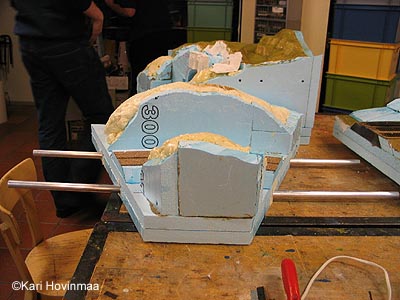
The middle part and removable aluminium tubes...
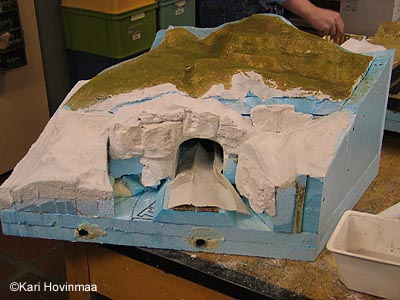
Tunnel end has plaster (Hydrocal) castings in place...
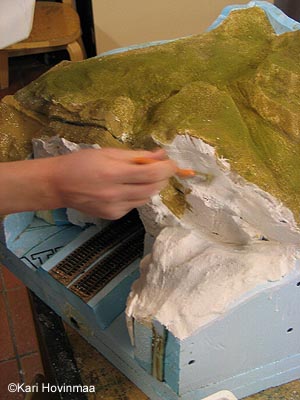
and the surroundings are covered with 'Cellona' bandage that is laid
dry and wetted with paintbrush...
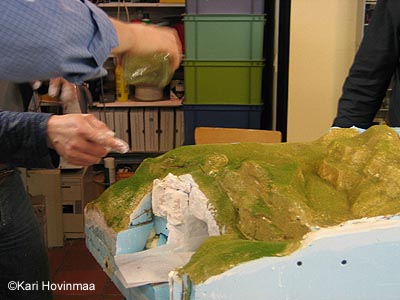
... and painted with dilluted latex paint, and basic scenery material is sprinkled to wet paint
and further glued with Noch scenery glue.
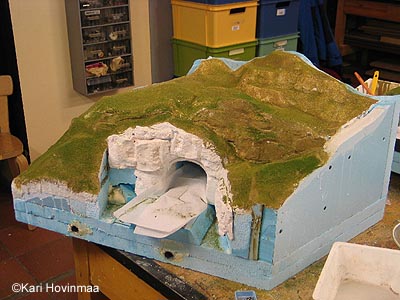
Corner module after two club nights.
Corners with set track (RocoLine)
To shorten the layout (we need to fit into smaller halls as well) we must get rid of the transition module to the left of Kauniainen station. The only way is to combine corner module with transition module: The kauniainen project system has 60 cm (2 ft.) deep modules and the track runs 50 and 100 mm (2" and 4") from the module centre line. To combine the transition module and corner module we are forced to radius of 850+800 mm (33.5" + 31.5") or less. Using flexible track with foam module structure has been somewhat painfull to us especially if we need to get a curve at the internal interfaces of the present three-part corner modules (we should have used PCB-slepers from the beginning and solder the track to sleepers prior cutting, but as we were in a hurry to get into exhibition the flex wasn't equipped w. PCB sleepers, and we have kinks all over the place now, and repair afterwards is not fun!) Hence a test module(s) will be made using set track.Members longest brass locos are negotiating only 600mm (2 ft) curves so we need to find set track elements for radius 600+650mm (24+26") or more, yet less that 800mm (31.5"). RocoLine track is readily available here, but unfortunately some radii are missing from their production line: R5 + R6 would have been good, but the radius is too tight and R9+R10 is a bit too wide. So a possible solution could be this:
- red=> RocoLine R6=> 604,4 mm
- green=> RocoLine R9=> 826,4 mm
- blue=> RocoLine R10=> 888,0 mm
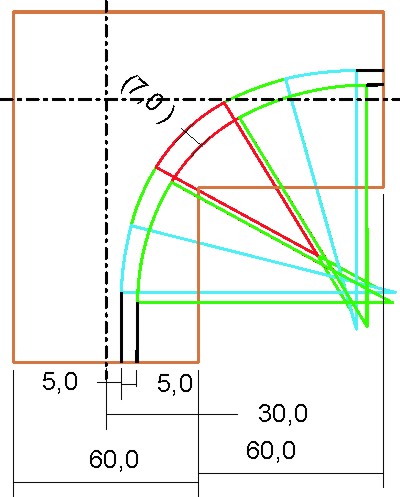
Here is a combined transition+corner, module size 120x120cm (4" x 4") (dimensions in cm's):
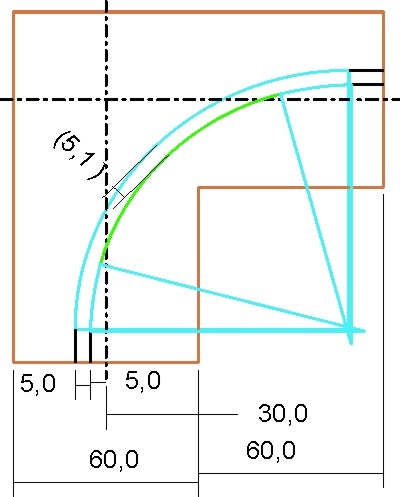
For comparison a normal curve done with set tracks:
10548 kävijää/visitors
© 1996-2023 Tapiola Parish Model Railway Club / Tapiolan seurakunnan pienoisrautatiekerho, Viimeksi päivitetty / last modified (none). Created with Notepad.
Text, drawings and photos are protected by copyright laws. Technical solutions, methods and source code are public domain only for non commercial purpose. All development has been carried out during our free time, mainly funded from our own pocket and with non selfish goals, so the use of this material for profitable use (including construction for a friend aginst a fee) is forbidden without written permit from the club. The pages contain errors, so, if you use the data given, you do so at your own risk and responsibility. If you further develop material found on these pages you must put it on display without fee e.g. to a freely available web page. We expect a note about this also.
Pages tested with W3C validator -- didn't look good ;)
[YHTEYSTIEDOT] Älä lähetä sähköpostia!
Tekstit, kuvat ja piirokset ovat tekijänoikeuslain suojaamia. Tekniset ratkaisut, menetelmät ja lähdekoodit ovat vapaasti kopioitavissa ja hyödynnettävissä ei-kaupallisissa tarkoituksissa. Kaikki kehitystyö on tehty vapaa-aikana ja pääosin henkilökohtaisilla varoilla eikä hyötymistarkoituksessa, siksi materiaalin käyttö hyötymistarkoituksiin (sisältäen kaverille rahasta rakentamisen!) on kielletty ilman kerhon kirjallista lupaa! Sivuilla esiintyy virheitä. Jos käytät sivujen tietoja hyväksesi, teet sen täysin omalla vastuullasi. Mikäli kehität sivuilla esiettyjä ajatuksia kytkentäkaavioita tai koodia edelleen, on sinun asetettava se maksutta kaikkien saataville esimerkiksi Internetiin. Odotamme vastavuoroisesti tietoa suoritetusta edelleenkehitystyöstä.
Sivut testattu W3C validatorilla -- ei näyttänyt hyvältä ;)